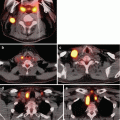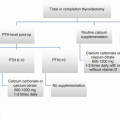© Springer International Publishing Switzerland 2017
Sanziana A. Roman, Julie Ann Sosa and Carmen C. Solórzano (eds.)Management of Thyroid Nodules and Differentiated Thyroid Cancer10.1007/978-3-319-43618-0_1818. Thyroid Nodular Disease and Thyroid Cancer During Pregnancy
(1)
The Thyroid Section, Department of Medicine, Brigham & Women’s Hospital and Harvard Medical School, 75 Francis Street, Building PBB-B4, Room 415, Boston, MA 02115, USA
Keywords
Thyroid nodulePregnancyThyroid cancerFine needle aspirationThyroid nodules are common, though the prevalence is markedly influenced by age and sex. Most analyses of patients presenting for initial nodule evaluation confirm a female to male predominance greater than 4:1 [1]. While the formation of new and multiple thyroid nodules is influenced by advancing age, the burden of disease on young women remains substantial. The principle purpose for thyroid nodule evaluation is to identify thyroid cancer and, more specifically, to guide treatment for those patients in whom thyroid cancer may pose a future risk to good health. Pregnancy itself has a profound influence on thyroid physiology [2], and thus the impact of gestation upon nodule formation, malignant transformation, and cancer behavior must be considered. Clinically, the risks and potential contraindications associated with any intervention performed on pregnant women also must be taken into account. This chapter will focus upon thyroid nodular disease and thyroid cancer in women planning pregnancy or those currently pregnant. Thyroid nodular disease will first be discussed, focusing upon the prevalence, clinical evaluation, and treatment specific to the pregnant patient. Thereafter, discussion will focus on thyroid cancer care.
Thyroid nodules are estimated to occur in 20–50 % of the adult population [3], and new and multiple nodules are more frequent with advancing age [4]. Iodine deficiency can increase the prevalence of thyroid nodules in a population, though iodine supplementation strategies have improved in the United States and worldwide over the last half century. Given the slow growth rate of thyroid nodules [5], most newly detected nodules during pregnancy can be assumed to have been present before conception. Though both benign and malignant thyroid nodules grow with time, growth is most often slow, occurring over years. An exception to this can be the rapid expansion of a cystic nodule when internal hemorrhage has occurred. Demographically, it is important to note that the average age of pregnancy in the United States has been increasing over the last four decades, with the fastest growing demographic being women seeking pregnancy after the age of 30 years [6]. This, combined with the age-associated increase in nodularity, suggests the frequency of this illness among pregnant women will increase in the future.
Physiologically, pregnancy may modestly impact thyroid nodule formation and growth, albeit to a clinically insignificant degree. Kung and colleagues studied 221 newly pregnant patients, performing serial ultrasound examination throughout gestation. The proportion of patients with thyroid nodules increased by nearly 10 % from the first to the third trimester [7]. However, newly detected thyroid nodules were very small, most measuring less than 5 mm in diameter. Similar case-control analyses demonstrate an increased prevalence of nodularity among women previously pregnant in comparison to nulliparous controls [8]. It should be emphasized again that the clinical impact of such nodule formation is minimal and that these findings should not prompt routine monitoring of patients with nonmalignant nodules during gestation.
Evaluation of the Thyroid Nodule During Pregnancy
The evaluation of a thyroid nodule in a pregnant patient is similar to that of a nonpregnant patient, with select exceptions [9]. A thorough medical history should be performed and should seek to identify rare, high-risk findings such as persistent hoarseness of voice, neck pain, or new neck lymphadenopathy. Patients should be queried about exposure to ionizing radiation as a child, or the presence of thyroid cancer in the family, as both can increase the probability that a thyroid nodule may prove cancerous. The physical examination should illustrate the size, location, and characteristics of a thyroid nodule. Attention should be given to firm (or “rock-hard”) nodules, fixation to surrounding structures, new choking or aspiration when swallowing, or the presence of new, persistent lymphadenopathy. Following clinical risk assessment, pregnant women with suspected thyroid nodules should undergo ultrasound examination. As ultrasound does not transmit ionizing radiation, this test is safe during pregnancy and without contraindication. The ultrasound evaluation should include sonographic risk assessment of any nodules identified, such as cystic content, echogenic pattern, microcalcifications, and irregular margins, as these findings help assess risk of malignancy [10]. Measurement of serum thyrotropin (TSH) should also be obtained. Thereafter, patients with non-suppressed TSH values should be considered for ultrasound-guided fine needle aspiration (UG-FNA) of clinically relevant nodules. The decision to aspirate should be guided by clinical guidelines [9] and informed by the published literature. In general, solid nodules with abnormal sonographic findings should be aspirated when larger than 1 cm, while nodules with low or very low risk findings should be aspirated when larger than 1.5–2.0 cm, respectively. Purely cystic nodules should not be aspirated, as they are benign. UG-FNA is a safe procedure during pregnancy and is usually performed with subcutaneous lidocaine. Side effects of UG-FNA, beyond mild bruising, are very rare, while the information gained from cytologic analysis significantly improves thyroid cancer risk assessment.
There are no high-quality data suggesting that the cytologic analyses of thyroid nodule aspirations are affected by pregnancy. As most nodules have been present before (yet detected during) pregnancy, the distribution of FNA cytology results should mimic those seen in a young, nonpregnant population [11]. Approximately 70 % of thyroid nodules will be cytologically benign, while 5–10 % will be cytologically malignant, and ~5 % will be nondiagnostic. However, ~15–20 % of nodule aspirates are classified as cytologically indeterminate. Such aspirates demonstrate abnormal features concerning for malignancy, but are not sufficient to be called cytologically malignant. These nodules should be classified per the Bethesda system [12] and reported as atypia of undetermined significance (AUS), follicular neoplasm (FN), or suspicious for papillary carcinoma (SUSP). Such nodules prove malignant in 20–70 % of cases following histopathologic analysis.
The management of thyroid nodules detected during pregnancy should be guided by the sonographic and cytologic findings. In general, most cases of thyroid cancer detected during pregnancy behave in an indolent fashion [8, 13]. Therefore, a conservative approach to cytologically indeterminate or malignant nodules is often considered. Moosa and colleagues studied 589 patients with newly diagnosed thyroid cancer, performing a case-control study comparing 61 patients diagnosed during pregnancy with 528 patients diagnosed while not pregnant [14]. The time to treatment was delayed by 15 months in pregnant patients. Despite this delay in treatment, no attributable harm was demonstrated. Some studies have reported contradictory findings, though they remain difficult to interpret. Messuti and colleagues noted a high rate of persistent or recurrent disease when thyroid cancer was diagnosed during or shortly following pregnancy [15]. However, serum thyroglobulin levels were commonly >10 ng/ml at the time of I131 ablation, raising questions regarding the extent of initial resection and whether this might influence the finding of a biochemically incomplete response. Similar questions apply to a study by Vannucchi [16]. Given the possibility that such findings could be attributable to incomplete initial treatment, these findings should not refute previous, larger analyses demonstrating general safety. However, further research into this area remains important. It should separately be noted that thyroid surgery during pregnancy imparts an increased operative and hospital risk in comparison to nonpregnant patients. Kuy et al. investigated 31,356 women undergoing thyroid or parathyroid surgery between the years of 1999 and 2004 [17]. In women pregnant at time of surgery, operative complications (23.9 % vs 10.4 %), length of stay (2 days vs. 1 day), and total cost ($6873 vs. $5963) were all increased in comparison to nonpregnant controls.
Management of the Indeterminate Thyroid Nodule During Pregnancy
Thyroid nodules with indeterminate cytology are not definitely benign nor cancerous and remain a diagnostic dilemma. Recent data suggests that Bethesda classification can provide prognostic information well beyond simply implying the percentage risk of malignancy. Liu and colleagues studied nearly 1000 consecutive malignancies, retrospectively comparing preoperative cytology classification to final malignant histopathology [18]. Lower risk indeterminate categories such as atypia of undetermined significance (AUS) or suspicious for malignancy (SUSP) signal a likelihood of identifying lower risk variants of papillary thyroid carcinoma, as well as a reduced risk of metastatic disease or recurrence. This is in contrast to cytology classified as malignant, where the risk of tall-cell variant of PTC or distant metastatic spread is more likely. Together these data provide support for a more cautious and conservative approach to pregnant women with indeterminate thyroid nodule cytology. Furthermore, many such lesions prove benign following surgical removal. However, even if malignant, nodules with AUS cytology are much more likely to represent low-risk thyroid carcinoma. The potential harm attributable to delayed treatment until after delivery for low-risk, well-differentiated malignancy in a pregnant patient is generally minimal, while the risk of operative complications during pregnancy is increased.
In nonpregnant women, molecular diagnostic testing of cytologically indeterminate thyroid nodules has proven useful toward improvement preoperative cancer risk assessment [19, 20]. However, such tests are not recommended for use in pregnant women at this time, given the paucity of data currently available and the potential for misleading results. Most notable, the available RNA-based gene expression test (i.e., Afirma GEC) measures the expression of >160 genes. While some of the gene expression is directly related to the local tumor environment, it is also possible that other gene expressions may be influenced by hormonal changes of pregnancy. Thus, Afirma GEC test performance should be viewed as uncertain in the unique scenario of pregnancy and generally avoided. A separate molecular test is a panel of single gene (DNA) mutations. This test is made clinically available through many commercial vendors (e.g., miRInform Thyroid, Thyroseq). Mutations in oncogenes such as BRAF, RAS, and others, as well as fusion products of RET:PTC and PPAX8:PPARɣ, have been investigated for their ability to predict benign or malignant disease in nonpregnant patients [21]. While such somatic mutations are less likely to be influenced by pregnancy, there have been no investigations of these DNA-based tests in pregnant women.
In practice, BRAF V600E mutations have proven to be the most predictive of malignancy in nonpregnant cohorts. Thus, one could hypothetically rationalize testing for the presence of this mutation in scenarios where the presence of the BRAF V600E mutation would impact the extent of the surgery performed. Caution should be raised however, with regard to the interpretation of other gene mutations, most notably that of the RAS oncogenes (i.e., KRAS, NRAS, and HRAS). While somatic RAS mutations increase the risk that affected nodules are malignant, recent data demonstrate that RAS mutations frequently occur in benign thyroid nodules. In a small study, Medici and colleagues showed that many RAS-positive yet cytologically benign nodules do not behave as cancerous during close sonographic follow-up over many years [22]. Furthermore, repeat FNA cytology confirms no evidence of tissue transformation from benign to malignant disease. Therefore, at a minimum, these data suggest that a finding of a new genetic mutation in a thyroid nodule should not universally imply that such a nodule is malignant. In summary, due to the paucity of available investigative data as well as the concerns regarding accuracy, the use of molecular testing in pregnant women with indeterminate FNA cytology cannot be recommended at this time.
Stay updated, free articles. Join our Telegram channel

Full access? Get Clinical Tree






